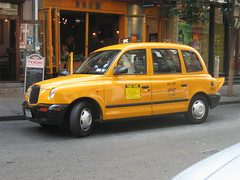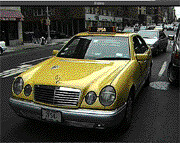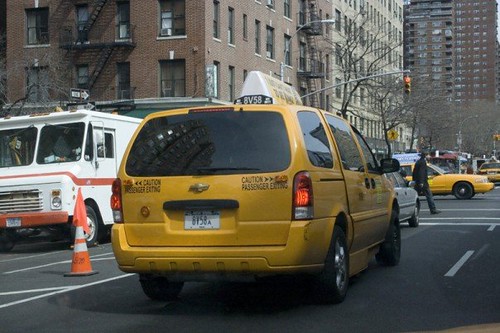A taxicab cannot just be painted yellow, get the taxi stickers and be on the streets. New cars first have to be suggested to the Taxi and Limousine Commission, then the TLC can decide to put vehicles through a probationary period, or not. During such a period, courageous drivers can decide to purchase the vehicles that are pending acceptance. The TLC then keeps a closer eye on the trial vehicles seeing if they can hold up to the stop and go, the potholes, the demons, and the tight twisty lanes of our so called expressways. Within three years or so it is decided whether these vehicles are worthy.
The LTI Taxi, famous as a London cab, even did a stint in our city. For some reason, I don't think it was approved. I don't ever see it anymore.
The LTI meets our growing need for a car with lots of passenger room with easy accessibility. One of the key qualifications for a taxi in London is to have a tight turning radius. The LTI, I could imagine, can turn in a tighter circle than any cab in New York, and possibly all of America. According to their own website, the new LTI gets 25.5 MPG in the city with an automatic, so I assume that translates to 20 mpg in NYC, not particularly special but still better than our Ford Crown Victoria. Also LTI's have a wheelchair access ramp that the driver can slide out from the passenger door to the curb. This one and only New York LTI cab was spotted circa 2005
The Mercedes-Benz E300 D is another extremely popular international taxi from what I've heard from friends who've been to Greece and Israel. Yeah we tried that one too, beats me why it didn't cut whatever is in our mustard. It was rumored that the one driver who owned it, only drove in midtown and would refuse all longer rides. I saw the Mercedes once; the dude was chillen' with his windows down and the sunroof open smoking a cigar. The car had no partition between the driver and passenger, which is a choice drivers can opt for if they purchase a camera that takes a picture of each passenger, however, if the taxicab was considered too small, the TLC might have mandated the camera instead of the partition. RayNYC, who found the image, did his research, and according to the TLC there were just two in operation. He also told me the driver told him the car was twice the price of the Crown Victoria, but gas was half the price. I saw the Mercedes E class taxi circa 1998.
Around the same time the two Mercedes' were on the road, two Lincoln Town Cars were being driven with taxi medallions too. Just like the Mercedes pictured above, they didn't seem to get the right hue of yellow paint as the rest of the taxis. The Town Car was doing extremely well in sales at this time, grabbing almost a strangle hold on the American limo market maintaining a large enough size to satisfy the clientele. A key feature was the air suspension which came in handy on the city streets, evening out almost all the bumps on the road to a smooth gentle ride.
Basically The Town car is a very glorified Ford Crown Victoria, and so for double the price, it wasn't worth using as a taxicab in my opinion, but there are differences such as the air suspension. Today both the Lincoln Town Cars and the Ford Crown Victorias hold respectively overpowering leads in the limousine and taxicab markets. It is their easy and cheap maintenance and reliability, plus their size, and their comfortable ride which give these cars their dominance in these markets. The Town Car outnumbers all other luxury cars by a huge margin in New York City. This market dominance grabbed hold in the early 90's when Lincoln's maintained a constant large size over the Cadilac which changed sizes of their cars from year to year, and Lincoln held the market with their good reliability. However the Town Car wasn't approved.
 was promised to drive 150 miles between charges and have a maximum speed of 80 miles per hour. Negatively it would take 6 hours to recharge and it would cost between 50 and 75 thousand dollars, however it was predicted to save a driver up to 15 thousand a year.
was promised to drive 150 miles between charges and have a maximum speed of 80 miles per hour. Negatively it would take 6 hours to recharge and it would cost between 50 and 75 thousand dollars, however it was predicted to save a driver up to 15 thousand a year.At the time it seemed almost as likely for this car to work as it did for the Ford Escape Hybrid. Retrospectively, the PT Cruiser was a laugher. This crack team of professionals who had bragging rights of working with government and (?) NASA contracts for electric vehicles, couldn't make a car capable for the job. It couldn't handle the cold weather for one. Secondly, only once did the Cruiser cruise for 90 miles, usually it only traveled 40 in a day, the rest of the time it was being towed. The average mileage I travel in my shift is between 100 and 200 miles, usually somewhere just under 150. This PT Cruiser must have been a hallucination, 'cause I never seen it.
image source here

The 06' Saturn Vue Green Line (25 mpg city) had a very short lived run as a taxi; so short I never saw the car. But according to this picture on the internet, much like the experimental Chrysler PT cruiser electric above, this too was once on city streets, for how long? an hour? who knows?
07' Chevrolet Uplander TC: Eldorado National Mobility
The Chevy Uplander TC (TC stands for Taxicab) seemed like a good choice for our new standard taxicab. A purpose built car to hold wheelchairs and be a taxi. It was the first of our approved taxis to hold wheelchairs without being jacked up to unsafe height in the rear, as it accepted wheelchairs through the passengers door rather than the trunk. But for one reason or another (it probably wasn't a very good vehicle) it didn't last on the Taxi and Limousine Commission's list. And so as quick as they came in to the New York taxi world, they were gone. The Dodge Caravan with the wheelchair package has replaced the Chevy as the American car choice for wheelchairs, and as the only approved car to take the wheelchair from the passenger doors. While the Toyota Sienna wheelchair kit has replaced the Ford Freestar as the new wheelchair unfriendly car that accepts the wheelchair in the trunk area. I must say none of these wheelchair models look very good, not even the ones still approved for purchase to use as a yellow-cab, we need a better solution. I've wrote some about, and posted pictures of those other wheelchair taxis still in use over here at Present Taxi Models
My shot of the Uplander TC






4 comments:
The E class is the state kind of taxi in Germany. Most drive him with the 136 HP of engine (diesel). In to the USA this engine is not offered. In Germany 60 percent of all taxi drivers drive Mercedes.
I enjoy your blog.
By the way, the LTI TX2 London taxi was owned by Team Systems of Long Island City. It was in service for about a year. It was then sold to someone in Ontario, Canada. That person put it on Ebay. The cab had about 37K miles on it at the time it was being auctioned on Ebay.
Thanks very much for that, much appreciated.
While I can't speak to the TC version of the Uplander, or the wheelchair package, I did put considerable, and vigorous, mileage on a "civilian" model as a trucking safety inspector. This involved quite a lot of dodging through traffic, with considerable jockeying of the throttle. Of the dozen or so vehicles I used in this capacity, the Uplander was the most reliable, needing no unscheduled repairs at all during the year or so I used it.
I also managed to maintain a mid-20s mpg in the process.
I think, in less oppressive business environments, it would make a fine taxi.
Post a Comment